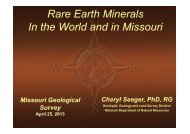Create successful ePaper yourself
Turn your PDF publications into a flip-book with our unique Google optimized e-Paper software.
REE deposit <strong>in</strong> Wyom<strong>in</strong>g and is currently welladvanced<br />
<strong>in</strong> exploration, <strong>in</strong>clud<strong>in</strong>g metallurgical<br />
and environmental studies directed toward m<strong>in</strong>e<br />
development (Rare Element Resources, 2013a).<br />
Exploration <strong>in</strong> other parts of Wyom<strong>in</strong>g that<br />
eventually resulted <strong>in</strong> identification of REE or<br />
REE-bear<strong>in</strong>g m<strong>in</strong>erals similarly focused first on<br />
uranium and thorium. Paleoplacers <strong>in</strong> the Bald<br />
Mounta<strong>in</strong> area of the Bighorn Mounta<strong>in</strong>s were<br />
first exam<strong>in</strong>ed for low-grade gold <strong>in</strong> the latter half<br />
of the 19 th century. Dur<strong>in</strong>g late summer of 1950,<br />
these paleoplacers <strong>in</strong> the lower part of the Flathead<br />
Sandstone were found to host radioactive monazite<br />
and were <strong>in</strong>vestigated by the USBM <strong>in</strong> 1951 (Kl<strong>in</strong>e<br />
and W<strong>in</strong>kel, 1952). Evaluation of the Bald Mounta<strong>in</strong><br />
area paleoplacers for monazite and its thorium<br />
content by the AEC <strong>in</strong> 1952 (McK<strong>in</strong>ney and<br />
Horst, 1953) showed a significant resource, but<br />
the study concluded that it could only be m<strong>in</strong>ed<br />
economically if the price per ton for the monazite<br />
was significantly higher. No analyses for REE accompanied<br />
reports from these <strong>in</strong>vestigations. This,<br />
and other reports of early exploration, focused on<br />
uranium and thorium rather than on REE, which<br />
were hosted by some of the same m<strong>in</strong>erals but<br />
appeared to be ignored at the time. However, the<br />
USBM reported <strong>in</strong> the 1956 M<strong>in</strong>erals Yearbook<br />
that U.S. Yttrium, Inc. <strong>in</strong> Laramie, Wyom<strong>in</strong>g was<br />
conduct<strong>in</strong>g exploration and research <strong>in</strong> <strong>rare</strong> <strong>earth</strong><br />
metals <strong>in</strong> the Bald Mounta<strong>in</strong> area.<br />
M<strong>in</strong>or amounts of REE-bear<strong>in</strong>g m<strong>in</strong>erals were<br />
reportedly m<strong>in</strong>ed <strong>in</strong> Wyom<strong>in</strong>g from at least three<br />
locations. Marzell (1933) reported production of<br />
363 kg (800 lbs) of samarskite from Wyom<strong>in</strong>g <strong>in</strong><br />
1930, but left the source of the material unknown.<br />
Allanite-bear<strong>in</strong>g ore was reportedly extracted from<br />
the Beaver Creek prospect <strong>in</strong> the Bighorn Mounta<strong>in</strong>s<br />
<strong>in</strong> southern Johnson County, between 1952<br />
and 1955, but neither production nor process<strong>in</strong>g<br />
records exist (Bromley, 1955; K<strong>in</strong>g and Harris,<br />
2002). The Platt m<strong>in</strong>e <strong>in</strong> the Big Creek district<br />
on the west side of the Medic<strong>in</strong>e Bow Mounta<strong>in</strong>s,<br />
produced approximately 4,500 kg (10,000 lbs)<br />
of euxenite from a pegmatite between 1956 and<br />
1958 (Houston, 1961). Other sources reduce this<br />
figure to 1,800 kg (4,000 lbs), and state that 5,900<br />
15<br />
kg (13,000 lbs) of ore produced from this m<strong>in</strong>e <strong>in</strong><br />
1956 was for uranium (K<strong>in</strong>g and Harris, 2002).<br />
Recent REE exploration <strong>in</strong> Wyom<strong>in</strong>g, beyond the<br />
Bear Lodge deposit, began <strong>in</strong> 2009 and cont<strong>in</strong>ues<br />
to the present. Targets of renewed <strong>in</strong>terest <strong>in</strong>clude<br />
placers, paleoplacers of several ages, alkal<strong>in</strong>e igneous<br />
complexes, pegmatites, and possible carbonatites.<br />
GEoLoGIc occurrEncEs of<br />
WyoMInG rEE<br />
Reported Precambrian REE occurrences <strong>in</strong> Wyom<strong>in</strong>g<br />
are hosted by pegmatites, ve<strong>in</strong>s and dikes,<br />
faults and shear zones, metacarbonate rocks of<br />
uncerta<strong>in</strong> orig<strong>in</strong>, dissem<strong>in</strong>ated m<strong>in</strong>erals <strong>in</strong> generally<br />
alkalic igneous rocks, and <strong>in</strong> metasediments,<br />
<strong>in</strong>clud<strong>in</strong>g paleoplacers (K<strong>in</strong>g and Harris, 2002).<br />
Paleozoic and Mesozoic occurrences <strong>in</strong>clude paleoplacers<br />
<strong>in</strong> both the Cambrian Flathead Sandstone<br />
and the Cretaceous Mesaverde Formation, and dissem<strong>in</strong>ations<br />
with<strong>in</strong> phosphate rock of the Permian<br />
Phosphoria Formation. Tertiary REE concentration<br />
hosts <strong>in</strong>clude alkali igneous rocks, related carbonatite<br />
ve<strong>in</strong>s, dikes, hydrothermal zones, and some<br />
paleoplacers. Quaternary REE hosts are alluvial<br />
placers, paleoplacers, and some hot spr<strong>in</strong>g deposits.<br />
The most outstand<strong>in</strong>g REE occurrence <strong>in</strong> Wyom<strong>in</strong>g<br />
is the carbonatite-hosted Bear Lodge deposit<br />
currently under exploration by Rare Element<br />
Resources. The Bear Lodge REE deposit is centered<br />
on carbonatite dikes associated with Eocene (46 to<br />
50 Ma) alkalic <strong>in</strong>trusive rocks. In this deposit, the<br />
m<strong>in</strong>erals ancylite and bastnasite conta<strong>in</strong> most of<br />
the REE, which are dom<strong>in</strong>ated by the LREE cerium,<br />
lanthanum, neodymium, and praseodymium.<br />
However, at the Whitetail Ridge deposit and<br />
the Carbon target, HREE-enrichment primarily<br />
occurs as elevated yttrium-HREE <strong>in</strong> parasite<br />
and synchysite; at Taylor Ridge and westward,<br />
yttrium-HREE enrichment appears to occur with<strong>in</strong><br />
xenotime and an unidentified yttrium-vanadium<br />
phosphate (Jim Clark, Rare Element Resources,<br />
personal communication, April 2013). Potential<br />
exists <strong>in</strong> other parts of Wyom<strong>in</strong>g for the discovery<br />
of carbonatites that host REE.



